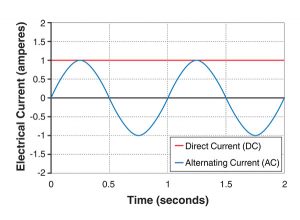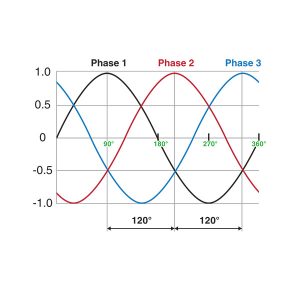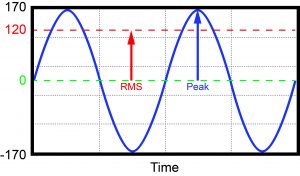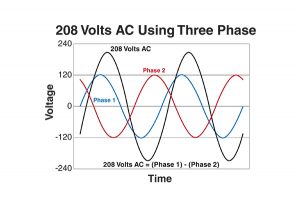
Sorting through the finer points of AC and DC voltages
May 30, 2018 | By Curtis Bennett
We all know, young or old, what comes to mind when we see the word Thunderstruck: AC/DC. This serves two purposes here, one is that the band is awesome and two, it is a good segue into the next Electricity 101 topic: AC versus DC voltages. We will delve deeper into voltage, a topic mentioned in HPAC March 2018.
Some readers may not know that I am not a total nerd. I grew up in rural Alberta and what that meant was motorbikes and snowmobiles (I date myself saying snowmobiles and not sleds). What that meant is we fixed a lot of stuff, including motors, suspension tracks, or whatever broke down. I later transitioned to cars. This led me down the dark path of drag racing–a sport that will take every penny from you and give nothing back but adrenaline and late nights. I occasionally helped a friend who had a blown alcohol dragster. Now that was a car to work on.
 One day we were trying to find out why we had a dead cylinder so we were testing the spark plug. To do that you take the spark plug out and keep the plug wire attached to it. Normally the spark plug is placed on the engine so it has a route to ground (as discussed in March) but this car rumbled too much. Someone had to hold the plug down on the engine so the circuit could close and we would have current flow. I chose to hold the plug wire as it is usually the safest place to hold onto. Not this time.
One day we were trying to find out why we had a dead cylinder so we were testing the spark plug. To do that you take the spark plug out and keep the plug wire attached to it. Normally the spark plug is placed on the engine so it has a route to ground (as discussed in March) but this car rumbled too much. Someone had to hold the plug down on the engine so the circuit could close and we would have current flow. I chose to hold the plug wire as it is usually the safest place to hold onto. Not this time.
When the voltage gets higher and higher it is able to, for lack of a better term, jump from place to place to place. In this case the voltage came out in a crack in the spark plug wire. I got shocked. As we turned the engine over, the distributor put 30,000 volts DC out to that wire. It did not go out the spark plug to ground it went through me to ground. As it hit me I let go and proceeded to yelp and start walking. As I walked I got lower and lower until I was almost falling over. It hurt a lot. Thankfully it was a lot of voltage with not a lot of current so it was not going to kill me. This scenario illustrates two things: DC voltage and high voltage.
A car has a battery and a battery is always DC voltage. DC stands for direct current meaning that the current can only flow in one direction. You have a positive and a negative–that is it. The voltage does not alternate. When you have a DC voltage the voltage is constant, meaning it does not go above and below 0 as AC voltage does. A car ignition and all of its other parts run from 12VDC (the battery) and in the case of the ignition the 12VDC gets up converted by the use of a coil (transformer), to about 30,000 volts. It needs a high voltage to jump the gap in the spark plug.
Have you ever wondered why power lines are spaced the way they are? The spacing ensures the voltage does not jump from one line to another. The higher the voltage the farther the spacing needs to be. This is also the same reason why a shock from static can go so far.
As we said in the March article, voltage is the force pushing so the harder we push the farther it can jump. The most common DC item that we know of is a battery. All batteries are DC voltage regardless of their chemistry. DC voltage is not normally used to power anything in the mechanical room but all electronics at their heart use DC. Most electronics nowadays have gone from 5VDC all the way down to 1.8 or even 1.2 for use in cell phones. The lower the voltage the lower the current draw from the device is and so the longer the battery lasts.
AC voltage is a term we commonly hear in mechanical rooms. DC stays in the controls but AC is what does the main powering and switches numerous things on or off. The term AC stands for alternating current. The voltage goes above and below 0v a set number of times.
In North America we use 120Vac at the frequency of 60Hz for most residential uses. 60Hz means that the voltage goes from positive to negative 60 times per second. To throw a tiny wrench into this, 120Vac is actually 170v peak on the positive side and 170v peak on the negative side. When we say 120Vac this is actually the Root Mean Square or RMS voltage. To recap, 120Vac is actually a 170v peak-to-peak wave that crosses 0v 60 times per second. When a volt meter is put on the wires to measure AC it is actually measuring RMS voltage. That is why you see 120Vac and not 170Vac.
What other voltages do we see in the mechanical room? Well the other common one would be 24VAC. This voltage is usually called “control voltage.” I find it funny that control guys do not like to work with 120Vac and electricians do not like to work with 24Vac. The principle is the same for each voltage. But where does the 24Vac come from? The good thing about AC voltage is that it can be stepped up or stepped down very easily by transformers.
We will talk more about transformers in HPAC August, for now know that you can step up or step down voltage with transformers. That is where we get the 24Vac. We are using a step down transformer, which means we connect 120Vac to incoming and 24Vac comes out the other side. We use 24Vac for many things inside the mechanical room, valves are a big one, powering controls is another and probably the one you know the most is powering thermostats.
 Another voltage you may hear is 208 or 240 single phase. This is more complex. This is where our nemesis three-phase comes into play. Let’s start with 240Vac. When power comes into a house there is normally two 120Vac phases. These “phases” are brought to the house so you can have different circuits and not all items are running off one circuit. If you have too much running on one circuit it can overload the lines and start a fire.
Another voltage you may hear is 208 or 240 single phase. This is more complex. This is where our nemesis three-phase comes into play. Let’s start with 240Vac. When power comes into a house there is normally two 120Vac phases. These “phases” are brought to the house so you can have different circuits and not all items are running off one circuit. If you have too much running on one circuit it can overload the lines and start a fire.
Phase is probably a term you have heard before. It is basically the voltage coming in on one wire at a certain frequency with respect to where it crosses 0. So, are you ready? From the two phases of 120Vac each coming into a house you can build other voltages. These voltages coming in are exactly 180 degrees OUT of phase, which means that when phase one is at +120V the other phase is at -120V. This doubles the voltage and gives us 240Vac. I am not going to get into the math, but trust me this is what happens. This is how you get 240Vac in a house or building.
If you are in an office building or a special house you may have three-phase also coming in. All three phases coming into the building are only 120 degrees out of phase (three phases X 120 degrees = 360 degrees). If you use two of those phases you get 208Vac. Figure 3 shows that when phase one is at the top phase two is not quite all the way at its lowest. That is why we get 208 instead of 240.
Now the big difference with 120Vac and 208-240Vac is that essentially 120Vac only is made up of one hot line, a neutral and a ground. For 208-240Vac the voltage is made up of two hot lines and a ground, and a neutral depending on a few factors. You have probably seen on most pumps that they are rated for 208-240, this means that they are ok to run from 208Vac (made up from three-phase power) or 240Vac (made from two separate 120Vac coming in) so keep that in mind next time you look at a pump.
If you used your volt meter on the 208Vac or 240Vac and tested from hot to ground you would see 120Vac. If you then test from the other hot line you will also see 120Vac, but if you measure from hot one to hot two you will see 208 or 230-240Vac depending on phases.
Keep in mind this is a generalization and there are a few other ways to come up with these configurations. Always follow the wiring guidelines in your area when starting to play around with 120Vac or higher–it can kill you. Always read and follow the warning labels, they are there for a reason. <>
Curtis Bennett C.E.T is product development manager with HBX Control Systems Inc. in Calgary, AB. HBX Control Systems was formed by Bennett and Tom Hermann in 2002. Its control systems are designed, engineered and manufactured in Canada to accommodate a range of hydronic heating and cooling needs commonly found in residential, commercial and industrial design applications.







